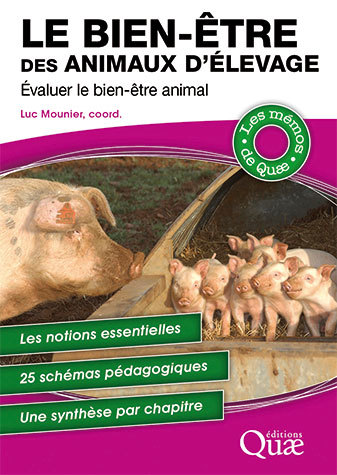Document type : Scientific overview published by Editions Quae
Authors: Luc Mounier, Alain Boissy, Alice de Boyer des Roches, Christine Duvaux-Ponter, Raphaël Guattéo, Marie-Christine Meunier-Salaün, Pierre Mormède
Preview: When seeking to improve the welfare of farm animals we have to be able to assess the level of welfare, positive or negative, of an animal or group of animals. The impetus may come from a farmer's general wish to find out how he or she is doing, but may also be provided by certification systems such as farm welfare labelling that aim to provide consumers with the information they need to make purchasing decisions. Certain regulated animal needs may also be subject to monitoring.
To assess animal welfare as objectively as possible, guidelines have been developed by an extensive range of stakeholders. Different indicators are used depending on the species, mode of production, age of the animals or type of farming involved, and these provide baselines from which to adapt on-farm assessments.
This booklet explains what welfare indicators are, how they are measured and how they are integrated to provide reliable information on the welfare level of a farm.
This is the second in a series of three booklets on animal welfare.
Contents: Chapter 1: Indicators for assessing animal welfare
1.1 The two main categories of indicator
1.2 Choosing between the two main categories of indicator
1.3 Indicators of welfare or degradation of welfare?
1.4 Assessing at the animal or herd level?
Chapter 2: Animal-based indicators
2.1 Early indicators
2.2 Behavioural indicators
2.3 Physiological indicators
2.4 Production indicators
2.5 Health indicators
2.6 The results of measuring the indicators
Chapter 3: Validation of indicators
3.1 Validation criteria
3.2 Validation of the measurement method
Chapter 4: Choosing which integration process should be used to assess animal welfare?
4.1 Why is an integration process necessary?
4.2 The purpose of the integration process
4.3 What are the main options for integrating large quantities of data?
Chapter 5: Implementation using evaluation protocols
5.1 The Welfare Quality® protocol
5.2 Other Welfare Quality® -derived protocols
5.3 Labelling developed by the French association Étiquette bien-être animal (Animal welfare label)
Chapter 6: The welfare improvement loop
6.1 Step 1: Assess the animals' welfare
6.2 Step 2: Identify the factors causing the degradation
6.3 Step 3: Propose and implement remedial actions
6.4 Step 4: Evaluate the measures implemented
Chapter 7: Contribution of new technologies to the assessment and improvement of animal welfare
7.1 Overview of tools available in the field
7.2 Ethical issues relating to connected objects
The pdf version of the booklet can be downloaded free of charge from the Quae website following registration.






